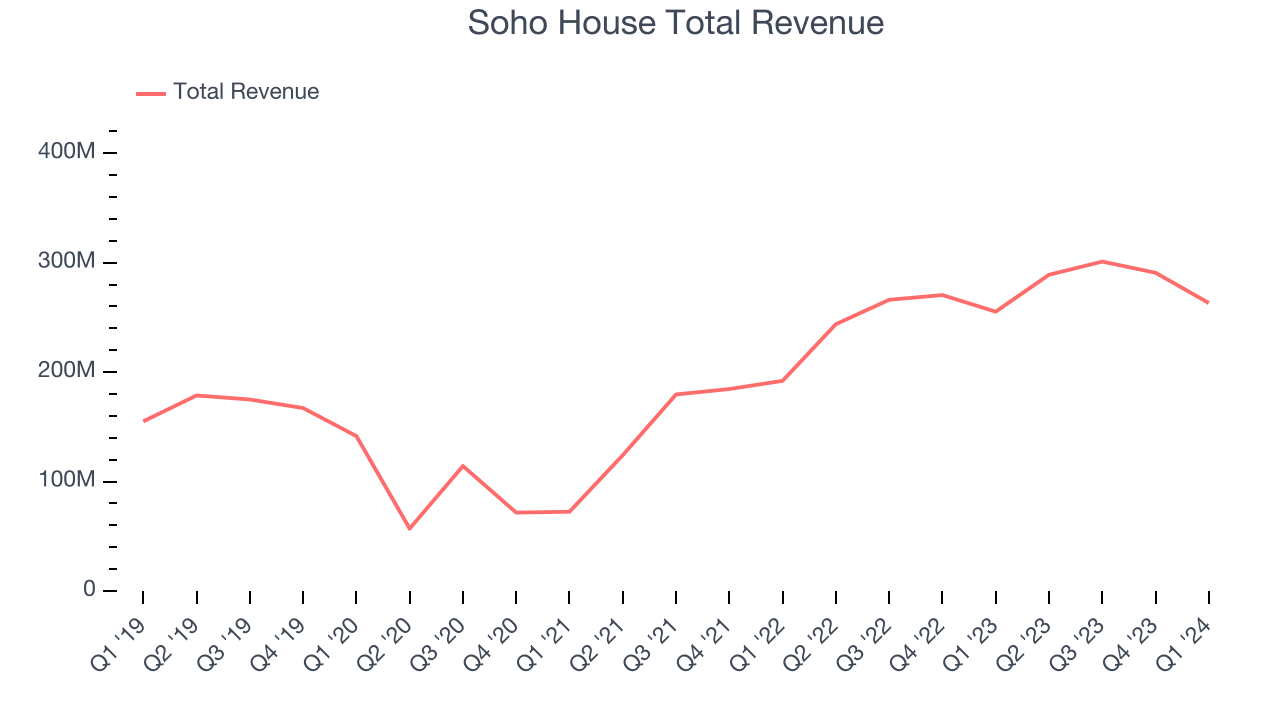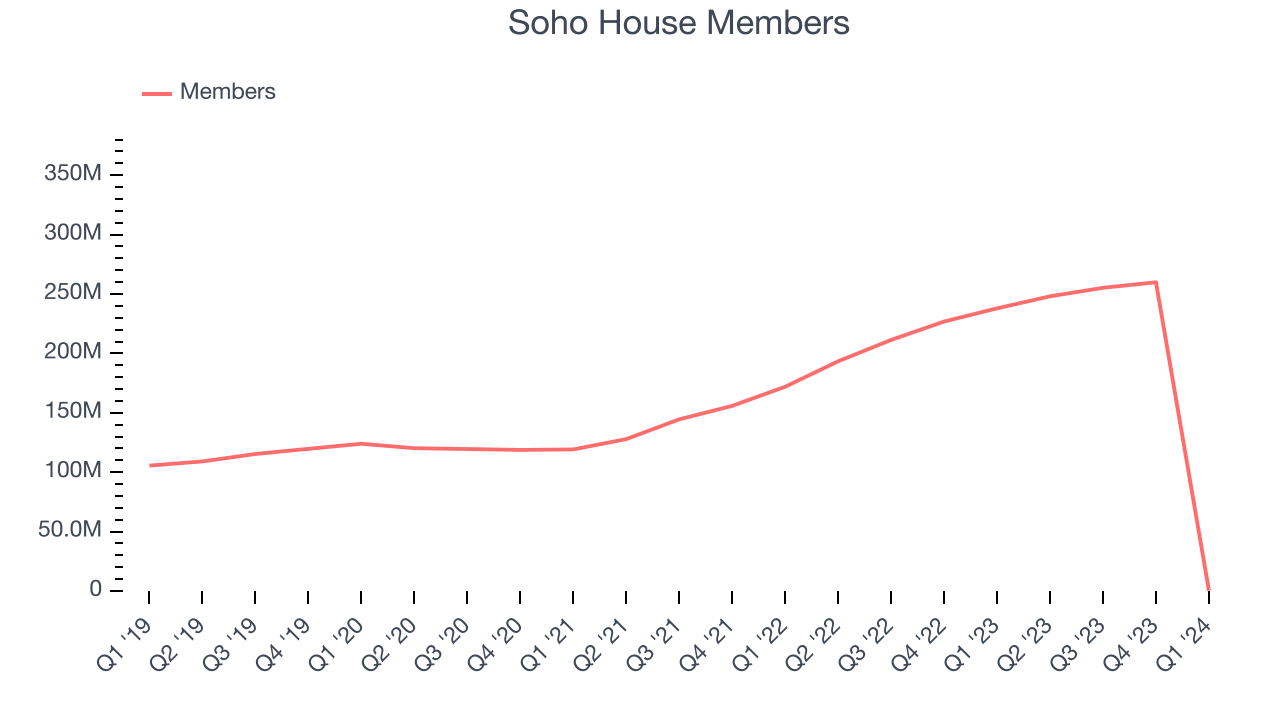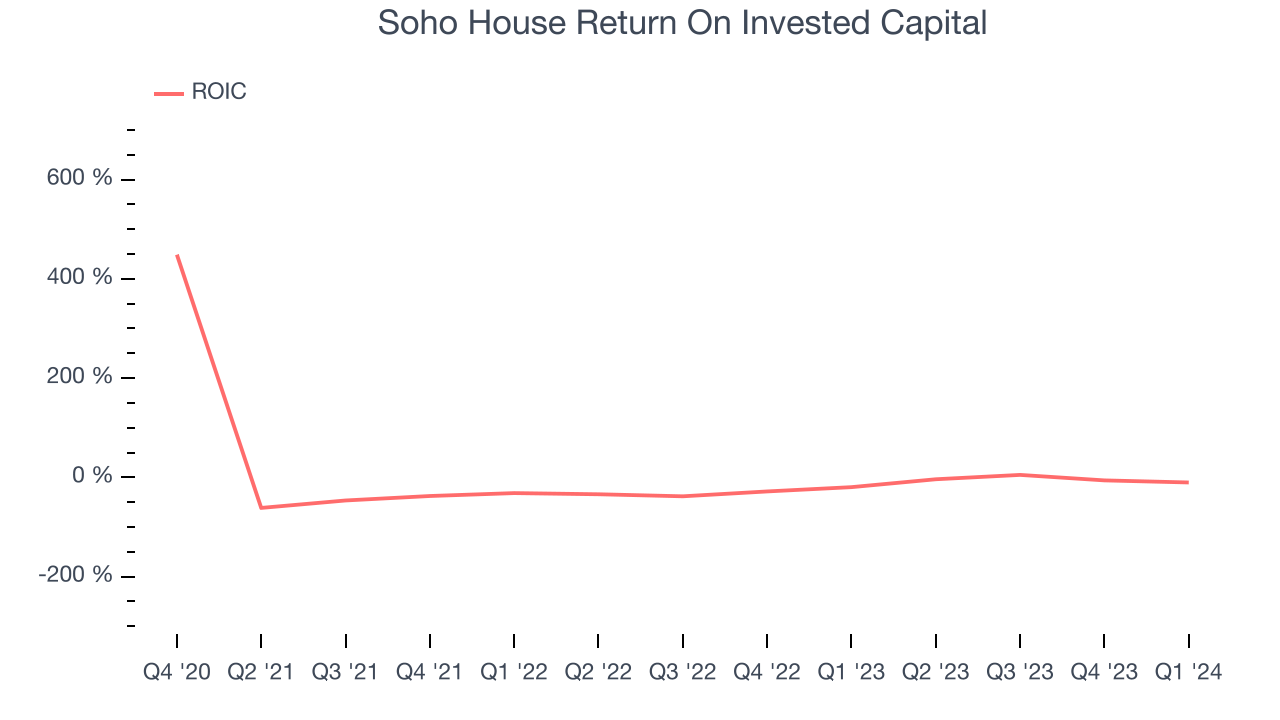Social club operator Soho House (NYSE:SHCO) reported results in line with analysts' expectations in Q1 CY2024, with revenue up 3.1% year on year to $263.1 million. The company's outlook for the full year was also close to analysts' estimates with revenue guided to $1.23 billion at the midpoint. It made a GAAP loss of $0.24 per share, down from its loss of $0.08 per share in the same quarter last year.
Soho House (SHCO) Q1 CY2024 Highlights:
- Revenue: $263.1 million vs analyst estimates of $263.5 million (small miss)
- EPS: -$0.24 vs analyst expectations of -$0.22 (8.7% miss)
- The company reconfirmed its revenue guidance for the full year of $1.23 billion at the midpoint
- Gross Margin (GAAP): 42.4%, down from 57.7% in the same quarter last year
- Free Cash Flow was -$13.52 million, down from $2.01 million in the previous quarter
- Members: 261,571
- Market Capitalization: $1.01 billion
Boasting fancy locations in hubs such as NYC and Miami, Soho House (NYSE:SHCO) is a global hospitality brand offering exclusive private member clubs, hotels, and restaurants.
Soho House began as a small, single-location private members' club for those in the film, media, and creative industries. Since then, the company has expanded its presence internationally, providing stylish, comfortable spaces for its creative community to socialize, work, and relax.
Today, Soho House operates nearly 30 clubs along with hotels, cinemas, spas, and workspaces. The "Houses", as they are known, are set in a variety of locations from bustling city centers to more rural, picturesque settings.
Each House is distinct, with interiors and experiences tailored to their local context. However, each shares a common thread of sophisticated and eclectic design, high-quality food and drink, and an atmosphere of exclusivity and comfort.
Membership to Soho House is selective, aiming to foster a diverse and dynamic community. Its members are granted access to its global network of Houses, along with benefits such as exclusive events, screenings, and workshops.
In recent years, Soho House has diversified its offerings even further to include public restaurants, branded home furnishings, and a line of skincare and grooming products, expanding its brand footprint in the consumer lifestyle sector.
Hotels, Resorts and Cruise Lines
Hotels, resorts, and cruise line companies often sell experiences rather than tangible products, and in the last decade-plus, consumers have slowly shifted from buying "things" (wasteful) to buying "experiences" (memorable). In addition, the internet has introduced new ways of approaching leisure and lodging such as booking homes and longer-term accommodations. Traditional hotel, resorts, and cruise line companies must innovate to stay relevant in a market rife with innovation.
Soho House's primary competitors include private companies The Groucho Club, The Hospital Club, Shoreditch House, The Arts Club, and The Ivy Club. Publicly traded competitors with slightly different business models include Marriott (NASDAQ:MAR), Hilton (NYSE:HLT), Hyatt (NYSE:H), and InterContinental Hotels (NYSE:IHG).Sales Growth
A company's long-term performance can indicate its business quality. Any business can enjoy short-lived success, but best-in-class ones sustain growth over many years. Soho House's annualized revenue growth rate of 14.6% over the last four years was mediocre for a consumer discretionary business.  Within consumer discretionary, a long-term historical view may miss a company riding a successful new property or emerging trend. That's why we also follow short-term performance. Soho House's annualized revenue growth of 29.7% over the last two years is above its four-year trend, suggesting some bright spots.
Within consumer discretionary, a long-term historical view may miss a company riding a successful new property or emerging trend. That's why we also follow short-term performance. Soho House's annualized revenue growth of 29.7% over the last two years is above its four-year trend, suggesting some bright spots.
We can better understand the company's revenue dynamics by analyzing its number of members, which reached 261,571 in the latest quarter. Over the last two years, Soho House's members averaged 18.2% year-on-year growth. Because this number is lower than its revenue growth during the same period, we can see the company's monetization of its consumers has risen. 
This quarter, Soho House grew its revenue by 3.1% year on year, and its $263.1 million of revenue was in line with Wall Street's estimates.
Operating Margin
Operating margin is a key measure of profitability. Think of it as net income–the bottom line–excluding the impact of taxes and interest on debt, which are less connected to business fundamentals.
Given the consumer discretionary industry's volatile demand characteristics, unprofitable companies should be scrutinized. Over the last two years, Soho House's high expenses have contributed to an average operating margin of negative 6.8%.This quarter, Soho House generated an operating profit margin of negative 9.5%, down 9.9 percentage points year on year.
EPS
We track long-term historical earnings per share (EPS) growth for the same reason as long-term revenue growth. Compared to revenue, however, EPS highlights whether a company's growth was profitable.
Over the last three years, Soho House cut its earnings losses and improved its EPS by 22.3% each year.
In Q1, Soho House reported EPS at negative $0.24, down from negative $0.08 in the same quarter last year. This print unfortunately missed analysts' estimates, but we care more about long-term EPS growth rather than short-term movements. We also like to analyze expected EPS growth based on Wall Street analysts' consensus projections, but unfortunately, there is insufficient data.
Cash Is King
Although earnings are undoubtedly valuable for assessing company performance, we believe cash is king because you can't use accounting profits to pay the bills.
Over the last two years, Soho House's demanding reinvestments to stay relevant with consumers have drained company resources. Its free cash flow margin has been among the worst in the consumer discretionary sector, averaging negative 2.9%.
Soho House burned through $13.52 million of cash in Q1, equivalent to a negative 5.1% margin, increasing its cash burn by 44.8% year on year.
Return on Invested Capital (ROIC)
EPS and free cash flow tell us whether a company was profitable while growing revenue. But was it capital-efficient? A company’s ROIC explains this by showing how much operating profit a company makes compared to how much money the business raised (debt and equity).
Soho House's five-year average return on invested capital was negative 20.4%, meaning management lost money while trying to expand the business. Its returns were among the worst in the consumer discretionary sector.

Balance Sheet Risk
Debt is a tool that can boost company returns but presents risks if used irresponsibly.
Soho House's $963.5 million of debt exceeds the $142.3 million of cash on its balance sheet. Furthermore, its 6x net-debt-to-EBITDA ratio (based on its EBITDA of $129.7 million over the last 12 months) shows the company is overleveraged.
At this level of debt, incremental borrowing becomes increasingly expensive and credit agencies could downgrade the company’s rating if profitability falls. Soho House could also be backed into a corner if the market turns unexpectedly – a situation we seek to avoid as investors in high-quality companies.
We hope Soho House can improve its balance sheet and remain cautious until it increases its profitability or reduces its debt.
Key Takeaways from Soho House's Q1 Results
We struggled to find many strong positives in these results. Its number of members unfortunately missed and its EPS fell short of Wall Street's estimates. Overall, this was a bad quarter for Soho House. The stock is flat after reporting and currently trades at $5.15 per share.
Is Now The Time?
Soho House may have had a tough quarter, but investors should also consider its valuation and business qualities when assessing the investment opportunity.
We cheer for all companies serving consumers, but in the case of Soho House, we'll be cheering from the sidelines. First off, its revenue growth has been mediocre over the last four years. And while its projected EPS for the next year implies the company's fundamentals will improve, the downside is its relatively low ROIC suggests it has historically struggled to find compelling business opportunities. On top of that, its cash burn raises the question of whether it can sustainably maintain growth.
While there are some things to like about Soho House and its valuation is reasonable, we think there are better opportunities elsewhere in the market right now.
Wall Street analysts covering the company had a one-year price target of $8.10 per share right before these results (compared to the current share price of $5.15).
To get the best start with StockStory, check out our most recent stock picks, and then sign up for our earnings alerts by adding companies to your watchlist here. We typically have the quarterly earnings results analyzed within seconds of the data being released, and especially for companies reporting pre-market, this often gives investors the chance to react to the results before the market has fully absorbed the information.
